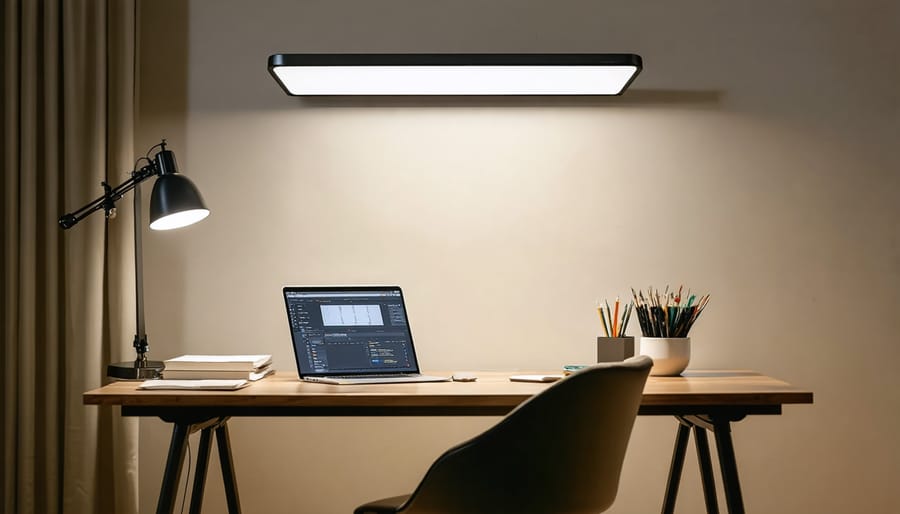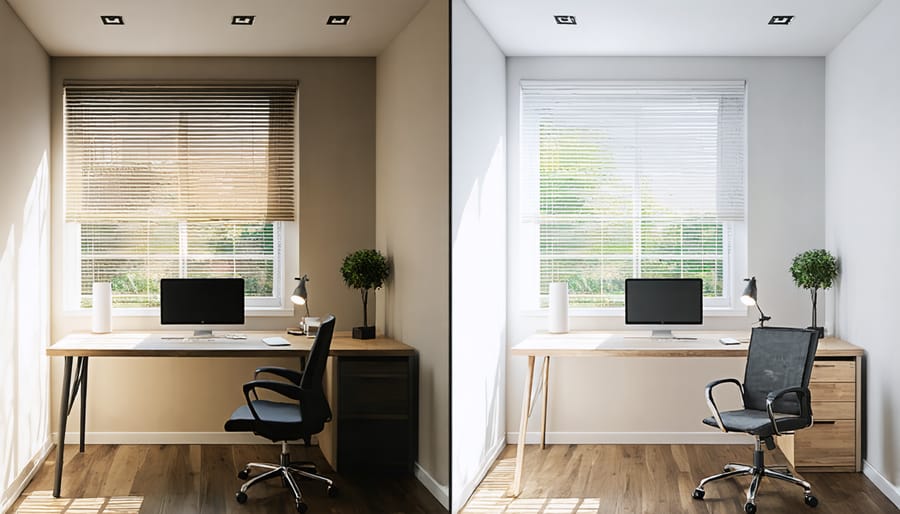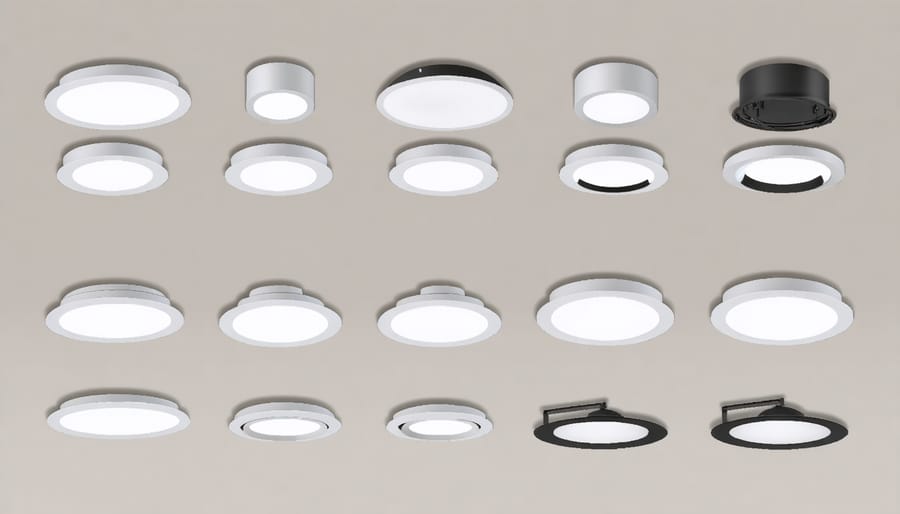
Transform Your Home Office with Perfect Overhead Lighting (No More Eye Strain)
Transform your home office productivity with strategic overhead lighting that eliminates eye strain and creates an energizing workspace. Modern LED panels, smart-enabled fixtures, and layered lighting solutions have revolutionized how we illuminate our home offices, making it easier than ever to achieve professional-grade lighting without complex installations or costly renovations.
The right overhead lighting doesn’t just illuminate – it enhances focus, reduces fatigue, and creates an environment where you can work efficiently for hours. Whether you’re video conferencing, reviewing documents, or crafting presentations, proper overhead lighting becomes your silent productivity partner, eliminating shadows and providing consistent, glare-free illumination throughout your workspace.
Today’s home office lighting solutions combine cutting-edge technology with practical design, offering options from voice-controlled smart bulbs to color-temperature-adjustable fixtures that mirror natural daylight patterns. These innovations help maintain your circadian rhythm while ensuring your workspace remains properly lit from dawn to dusk, making the home office a truly professional environment that adapts to your changing needs throughout the workday.
Why Overhead Lighting Makes or Breaks Your Home Office

The Science Behind Proper Office Lighting
The impact of office lighting on our daily work experience goes far beyond simple illumination. Research shows that proper lighting directly influences our productivity, mental alertness, and eye health and ergonomics. Natural light rhythms help regulate our circadian cycles, affecting everything from sleep patterns to energy levels throughout the day.
When working at a computer, lighting that’s too bright or too dim can cause eye strain, headaches, and fatigue. The ideal setup combines ambient overhead lighting (around 300-500 lux) with task lighting for detailed work. Color temperature also plays a crucial role – cooler, bluish light (4000-5000K) promotes alertness and focus during work hours, while warmer tones (2700-3000K) help create a more relaxed atmosphere.
Modern LED lighting solutions allow you to adjust both brightness and color temperature throughout the day, mimicking natural light patterns. This smart approach to office lighting has been shown to improve mood, reduce eye fatigue, and boost overall workplace satisfaction. By understanding these scientific principles, you can create an optimal lighting environment that supports both your wellbeing and productivity.
Common Overhead Lighting Mistakes
Many homeowners make common mistakes when setting up overhead lighting in their home offices, which can significantly impact their quality office environment. One frequent error is installing a single central light fixture that creates harsh shadows and uneven illumination. This can lead to eye strain and reduced productivity during long work sessions.
Another mistake is choosing fixtures that are too bright or too dim for the space. Overly bright lights can cause glare on computer screens, while insufficient lighting makes reading documents difficult. Many people also overlook the importance of color temperature, often selecting cool white bulbs that create an institutional feel rather than warm or natural white options that enhance comfort and focus.
Positioning lights directly above the workspace without considering screen reflection is another common oversight. This setup typically results in uncomfortable glare and forces users to adjust their monitor position constantly. Additionally, failing to install dimmer switches limits flexibility for different tasks and times of day, making it harder to adapt the lighting to changing needs.

Best Overhead Lighting Options for Your Home Office
Recessed Can Lights
Recessed can lights, also known as downlights or pot lights, offer a sleek and modern lighting solution for home offices. These fixtures sit flush with the ceiling, creating a clean, uncluttered look while providing focused, direct illumination for your workspace. The main advantage of recessed lighting is its ability to distribute light evenly across your office space without creating visual barriers or taking up valuable headroom.
When planning recessed lighting installation, consider spacing them 4-6 feet apart for optimal coverage. For a typical home office (120-150 square feet), 4-6 recessed lights usually provide sufficient illumination. Modern LED recessed lights offer excellent energy efficiency and often include smart features like dimming capabilities and color temperature adjustment.
Installation requires careful planning, especially regarding ceiling joists and insulation. While DIY installation is possible for those with electrical experience, professional installation is recommended to ensure proper wiring and placement. Consider installing the lights on separate switches to create lighting zones, allowing you to adjust illumination based on different tasks or times of day. Many modern recessed lights are also compatible with smart home systems, enabling voice control and scheduling options.
Modern LED Panels
Modern LED panels represent a revolutionary leap in home office lighting technology, offering an elegant solution that combines energy efficiency with superior illumination. These slim, lightweight fixtures mount directly to your ceiling and provide uniform, glare-free light that closely mimics natural daylight. Most panels feature adjustable color temperatures, allowing you to switch between cool white light for enhanced focus and warmer tones for a more relaxed atmosphere.
What sets contemporary LED panels apart is their smart functionality. Many models now integrate with home automation systems, enabling you to control brightness levels and color settings through your smartphone or voice commands. Some advanced panels even offer circadian rhythm programming, automatically adjusting the light throughout the day to match your body’s natural patterns.
Installation is typically straightforward, with many panels designed to replace traditional fluorescent fixtures or mount directly into drop ceilings. They consume significantly less energy than conventional lighting while lasting up to 50,000 hours, making them a cost-effective long-term investment for your home office. Plus, their ultra-thin profile creates a sleek, modern aesthetic that complements any workspace design.
Pendant and Chandelier Options
Pendants and chandeliers offer a perfect blend of form and function for your home office, creating an elegant focal point while delivering essential task lighting. Modern pendant lights come in various styles, from minimalist single-bulb designs to multi-light clusters that provide broader illumination. Consider installing a pendant light directly above your desk for focused work lighting, or opt for multiple smaller pendants arranged in a linear fashion for even coverage across your workspace.
Chandeliers have evolved beyond traditional crystal designs, now featuring contemporary materials like metal, glass, and even natural elements. Smart chandeliers with built-in LED technology offer customizable brightness levels and color temperatures, perfect for different work tasks throughout the day. Many models are compatible with smart home systems, allowing you to control your lighting through voice commands or smartphone apps.
When selecting either option, ensure the bottom of the fixture hangs at least 30 inches above your desk surface to prevent glare and maintain clear sight lines. For rooms with standard 8-foot ceilings, choose fixtures that are relatively compact to maintain proper proportions and avoid overwhelming the space.
Track Lighting Systems
Track lighting systems offer unparalleled flexibility for home office spaces, allowing you to direct light exactly where you need it. These systems consist of a mounting rail and adjustable light fixtures that can be positioned and angled individually, making them perfect for different desk arrangements or multi-functional workspaces.
Modern track lighting comes in various styles, from sleek contemporary designs to industrial-inspired fixtures. You can choose between halogen, LED, or even smart bulbs that integrate with your home automation system. The ability to add, remove, or reposition lights makes track lighting particularly valuable as your office layout evolves.
For maximum effectiveness, install tracks parallel to your primary work areas. Consider using a combination of spot fixtures for task lighting and wider-beam heads for ambient illumination. Many systems now feature dimming capabilities and color temperature adjustments, helping you maintain optimal lighting throughout the day.
When planning your track lighting setup, remember to account for potential glare on computer screens and ensure the system’s voltage matches your home’s electrical specifications. Most residential track lighting kits are DIY-friendly, though professional installation is recommended for complex configurations.
Smart Integration and Control
Smart Bulbs and Fixtures
Smart lighting has revolutionized home office illumination, offering unprecedented control and customization. By incorporating smart office technology into your overhead lighting, you can create the perfect environment for productivity and comfort.
Modern smart bulbs and fixtures connect to your home’s WiFi network, allowing you to control them through smartphone apps or voice commands. You can adjust brightness levels, color temperature, and even create custom lighting schedules that match your work routine. For example, you might program brighter, cooler light during peak work hours and warmer, dimmer light for evening tasks.
Many smart lighting systems offer preset scenes for different activities. Choose “Focus” mode for intense concentration, “Reading” for reduced eye strain, or “Conference” for optimal video call lighting. Some advanced fixtures even sync with your calendar to automatically adjust throughout the day.
Popular options include individual smart bulbs that fit standard fixtures, complete smart ceiling fixtures, and retrofit kits that convert existing fixtures. When selecting smart lighting, consider compatibility with your preferred smart home ecosystem (like Alexa or Google Home), the level of brightness you need, and color-changing capabilities.
Look for fixtures with high Color Rendering Index (CRI) ratings to ensure accurate color representation, especially important for design work or video conferencing. Most quality smart bulbs now offer energy monitoring and automation features that can help reduce your electricity costs while maintaining optimal lighting conditions.

Lighting Control Systems
Modern lighting control systems have revolutionized how we manage overhead office lighting, offering unprecedented convenience and customization. Smart switches and apps let you adjust brightness levels and color temperatures right from your smartphone, perfect for switching between focused work and video calls.
Popular smart lighting platforms like Philips Hue, LIFX, and Smart Things integrate seamlessly with voice assistants such as Alexa and Google Home. This means you can adjust your lighting hands-free with simple voice commands while staying focused on your work.
Automation is where these systems truly shine. You can schedule your overhead lights to automatically adjust throughout the day, mimicking natural light patterns to support your circadian rhythm. Set your lights to gradually brighten in the morning for a energizing start, then slowly warm and dim in the evening to signal it’s time to wind down.
Motion sensors can automatically turn lights on when you enter your office and off when you leave, helping save energy. Many systems also offer occupancy detection and daylight harvesting, which adjusts artificial light based on available natural light.
For more traditional control, wireless dimmer switches can be mounted anywhere without complex wiring. These battery-powered options offer the familiar feel of standard switches while providing smart functionality, making them perfect for those who prefer physical controls alongside app-based management.
Installation and Positioning Tips
DIY Installation Guidelines
Before starting any electrical work, ensure your power is turned off at the circuit breaker. Begin by identifying your ceiling joists using a stud finder and marking their locations with painter’s tape. For flush-mount fixtures, remove the existing light (if any) and install a new electrical box rated for your chosen fixture’s weight.
Connect the wires following your fixture’s instructions, typically matching black to black (hot), white to white (neutral), and green or copper to ground. Always use wire nuts and electrical tape for secure connections. For pendant lights, ensure your mounting hardware can support the fixture’s weight, and consider using a ceiling medallion to cover any imperfections in the junction box area.
When installing track lighting, mount the track to your marked ceiling joists using appropriate anchors and screws. Space the mounting points every 16 inches for stability. Connect the power supply to your track’s power feed connector, then snap individual light heads into place.
Test all connections before finalizing installation. If you’re unsure about any electrical work, don’t hesitate to contact a licensed electrician – safety should always come first.
When to Call a Professional
While many overhead lighting projects can be DIY-friendly, certain situations call for professional expertise. Consider hiring a licensed electrician if you’re installing new electrical circuits, relocating existing fixtures, or adding complex dimming systems. This is especially important when working with older homes that may have outdated wiring or when installing smart lighting systems that require specific voltage requirements.
Professional help is also recommended if you’re uncomfortable working with electrical connections or need to modify ceiling structures to accommodate new fixtures. Complex installations involving multiple circuits, smart home integration, or architectural features like coffered ceilings typically require expert knowledge and specialized tools.
Safety should always be your primary concern. If you encounter aluminum wiring, need to upgrade your electrical panel, or discover any code violations during your project planning, stop immediately and contact a qualified electrician. The investment in professional installation can prevent costly mistakes, ensure proper functionality, and provide peace of mind knowing your lighting system meets all safety standards and building codes.
Creating the perfect overhead lighting for your home office doesn’t have to be overwhelming. By focusing on the key elements we’ve discussed – layered lighting, proper placement, and smart technology integration – you can transform your workspace into a productive and comfortable environment.
Remember that the best lighting solution combines ambient overhead lighting with task-specific options, allowing you to adjust the illumination based on your needs throughout the day. Whether you choose recessed lights, track lighting, or a statement pendant fixture, ensure it provides adequate brightness without causing glare on your screens or work surface.
Don’t forget to consider energy efficiency and long-term cost savings by opting for LED bulbs and smart lighting controls. These modern solutions not only reduce your energy bills but also give you greater control over your workspace ambiance.
Take the time to plan your lighting layout carefully, considering both natural light sources and your primary work areas. If you’re unsure about installation, don’t hesitate to consult with a professional electrician to ensure safety and optimal performance.
Ready to upgrade your home office lighting? Start by assessing your current setup and implementing these lighting strategies one step at a time. Your productivity, eye health, and overall work satisfaction will thank you for making this important investment in your workspace.
